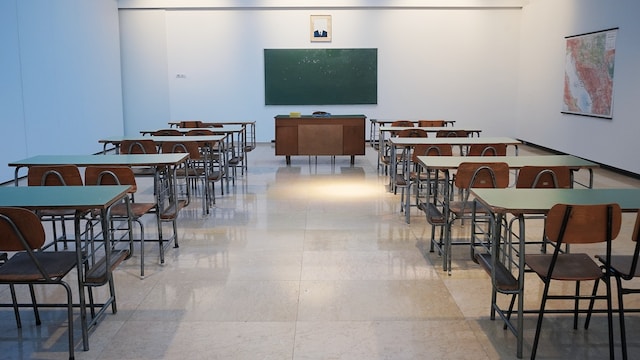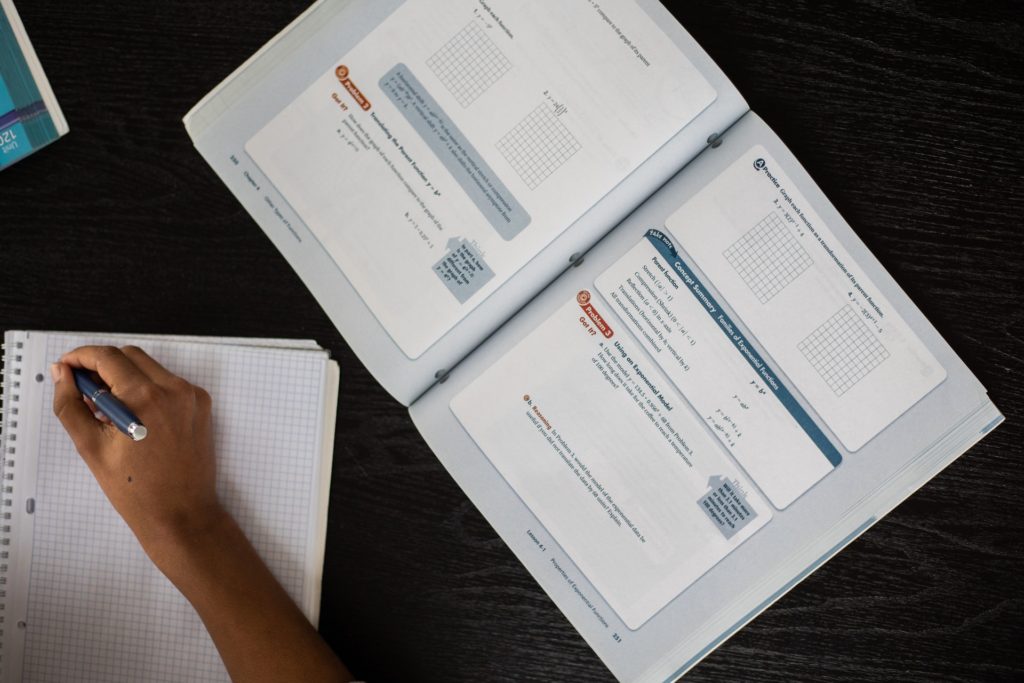Table of Contents
Classroom layouts refer to how desks, chairs, boards, computers and other educational equipment are positioned in a classroom. By far the most common layout is student desks laid out in rows facing a centrally located board or screen where the teacher is permanently stationed.
While this layout has been used by educators around the world for centuries and even longer in some cases, there is an increasing body of research that suggests there are significant benefits to using other classroom layouts. The ideal set up for each classroom will often be dictated by the physical space available along with the personal preferences of the students and teacher, but this article will discuss benefits of various layout ideas for teachers to consider incorporating occasionally into their existing structures.
Why Does Classroom Layout Matter?
Classroom Layouts Influence Behavior
One of the main reasons a teacher might consider changing the layout in their classroom is to change how students behave or interact with one another. By making changes to where desks are located and where they are facing, the classroom layout can have a significant psychological impact on students’ experience of class time.
Traditional rows tend to limit students’ ability to collaborate due to the physical space between their individual desks. By moving desks closer to one another and even having students face one another, students will be better able to work on projects together and discuss classroom topics.
Certain layouts can also have an effect on the teacher’s ability to monitor students. While rows may have been an easy way to separate students to keep them from chatting before technology, because many schools now use computers in class, the traditional set up has students’ screens hidden from the teachers view, making it easy for students to text, game, or otherwise be distracted without fear of the teacher seeing that they are off track.
ICT and Classroom Layouts
Information and Communication Technology like phones and computers are not simply a distraction, but are brought into classrooms due to their useful educational applications as well. Research has shown that certain classroom layouts influence how teachers are able to utilize technology in the classroom and when it ends up being too much trouble.
“Based on the findings of this study, we conclude that not only the technologies themselves, but also their physical placement in the overall classroom layout mediates their pedagogical usage. These kinds of decisions deserve to be carefully considered, not determined by happenstance, as is frequently the case. Further research is needed to help architects, school leaders and teachers make informed decisions regarding classroom layout and technology placement.” (Tondeur, et al.)
Sometimes students have to switch from working individually on their own devices, watching something as a whole class on a central display and then do group work with classmates. Oftentimes a single layout can struggle to be ideal for each of these activities and teachers may need to use multiple layouts rather than relying on there being one “best” permanent layout for their class.
Shifting Classroom Layout Addresses Monotony
Another benefit of changing classroom layouts is that it can also prevent boredom and monotony by keeping students active and working with different partners. Sitting in the same desk next to the same people can become stale and lead to students feeling like every day is the same.
By changing where and how students sit in the room, classes feel different and more like a unique experience rather than just another day at the grind. When one day is more individual and about thinking, listening, and watching at an individual desk but the next day’s class is group work and projects at large tables, students’ days will not simply blend together but be interesting new changes to learn with and benefit from.
Switching student partnerships is also useful whether students are happy with who they sit next to or can’t stand their neighbor. Breaking up overly reliant pairs of students and ensuring everyone learns to work with many types of people will help them in their futures.
Some teachers say that it is good to let students feel safe and comfortable with just one student, but in reality, this will limit students ability to work with others in their future and can also lead to them being close minded. Students need to be able to respectfully talk with, work with, and deal with all kinds of people and during classroom activities is a perfect learning space for students to experience different perspectives, worldviews, and communication styles.
Types of Classroom Layouts
Rows
The most basic type of classroom layout is simple rows of students all facing the front of the room. The teacher will often stay at the front of the room to give lectures or write on the board, or perhaps float between the rows of students to give one on one support when students are doing individual work.
Benefits
- Everyone is facing the board
- Great for putting focus on lectures or videos
- Keeps students from being distracted by nearby classmates
- Good for focus during tests or other activities without collaboration
Drawbacks
- Makes group work difficult if not impossible
- Puts responsibility for all learning on the teacher
- Is very boring for students
Pair Tables
If rows are too isolating, then perhaps simply pushing two desks together to create pairs can greatly increase students’ ability to collaborate with each other while still keeping the focus on the front of the room. This approach is particularly useful for listen-pair-share activities where students need to switch focus from learning from a lecture and then doing pair work before returning to focus at the front to share their work with the class.
Benefits
- Flexible happy medium between groups and lecture friendly layouts
- Can be useful to create helpful and supportive student pairings
Drawbacks
- Not all student pairings will be happy staying together or being separated
- Bad pairings can be worse than no collaboration at all
Tables
Pair Tables often seem like a halfway measure. To get all of the benefits of collaboration and multiple perspectives, it can often be better to simply put two pair tables together to create a group table.
This requires that students face one another rather than only the teacher, which may seem like a disadvantage at first, but is often beneficial in helping students focus on their own collaborative learning rather than simply waiting for the teacher to hand feed them learning. Rather than looking at the teacher with blank stares, they will look to one another to see what is supposed to be done, creating opportunities for individuals to be leaders at their table guiding discussions and keeping other members on track.
Additionally, having more voices prevents students from getting into bad pairs that only reinforce their bad behaviors or understanding and requires students to collaborate with a variety of individuals. However teachers should beware making tables much larger than six students per table.
Research shows that already at six students, certain seats will be viewed as preferential and this is likely to create conflict. (Kaya and Burgess) However, teachers should group students in a variety of table groups to help them learn to manage discussions and projects at various scales.
Benefits
- Creates genuine collaboration
- Gives students a variety of perspectives during group discussion
- Students face one another
Drawbacks
- Many opportunities for distraction
- Not all students can face the board
- Some groups can be chaotic while others will sit in silence.
Horseshoe
Students do not only need to be able to work in small groups, but sometimes in large groups that include the entire class. One of the most successful styles for this is horseshoe style, also sometimes called the campfire model.
In this style, students are placed in a ring or U shape around the board. This ring will often include the teachers desk which helps to equalize the power dynamics and make every student feel like an equal participant in class discussion rather than a pupil below the teacher.
This model can even be better for lectures as it is still easy for everyone to see the board, but also students are not distracted by what the student in front of them is doing. While they can always look to the sides, not having a distraction directly in the line of sight can be a huge help for easily distracted or disturbed students.
Encouragingly, research has shown that this is one of the most useful learning set ups for measurable learning. (Rogers) While this is only a very limited study, teachers should still consider doing away with rows for a few weeks to monitor how a horseshoe classroom layout works in their classrooms.
Benefits
- Makes everyone feel more equal
- Fantastic for whole class discussions
- Limits distractions
Drawbacks
- Can be intimidating for students who like to hide in the back
- While pair-sharing is possible, larger group work requires moving
- The teacher must go around the perimeter to be able to give help
Runway
Another creative classroom layout is having students in two rows facing one another. While certainly an interesting layout that will shake things up in the classroom, it has limited useful applications and significant downsides.
Most often used for formal classroom debates, having two rows that face one another can also be useful in other activities or where having a horseshoe would block access to exits. Generally, however, creating two distinct groups that directly face one another can create a sense of division and conflict rather than collaboration and equality.
Benefits
- Great for discussions and debates
- Can build team spirit and be fun for competitive activities
Drawbacks
- Divisive and intense
- Students at the back are not angled very well
Wall Facing Desks
Wall Facing Desks, also called a reverse horseshoe classroom layout may seem counterintuitive at first, but is a very common classroom model for anyone who has taught a class in a computer room. Desks are in a horseshoe shape, but facing the wall and usually have a computer against the wall for students to work on.
Though this layout may not be the first teachers think of for a temporary shift, it can still hold some benefits for some activities. Especially during tests or other times where students do not need to be facing the front, a reverse horseshoe can actually be optimal as it allows the teacher to see all screens at a quick glance to ensure no one is cheating or otherwise off task.
Benefits
- Students are less likely to be distracted by one another
- Teachers can easily monitor what all students are doing at a glance
Drawbacks
- Students are not facing a central location, making lectures impractical
- Only pair sharing is possible.
Workstations
Workstations are the most eclectic classroom layout teachers might choose. Though a more recently implemented model, it has quickly caught on in more progressive teaching circles because of its flexibility and focus on student centered learning.
Rather than all students working on the same things at the same pace, the teacher sets up various activities at various stations around the room. Some may be collaborative activities with a partner or small group, others may be individual work, and still others may be a mini lecture given by one or more teachers.
It is not always necessary for students to complete all stations. Sometimes simply having various options for how students can work on review allows students to work on their own areas of individual weakness and cover what they need to work on rather than what the “average student” needs to cover.
The types of activities at each station is only limited by the teachers creativity and the students ability to complete the activities independently. Since there are multiple stations in any station classroom layout, teachers can not be supporting students at all stages of their learning.
Benefits
- Puts the responsibility for work completion on students
- Allows for students to work at their own pace
- Gives students an element of choice and autonomy about how they would like to learn.
Drawbacks
- Requires significant student independence
- Requires extra planning and organization from the teacher
- Can lead to difficulty hearing or working due to noise levels from other stations
Conclusion
Classroom layouts are an important consideration for teachers. Research suggests that the layout of a classroom has a significant impact on how students feel, behave, and participate in class activities.
Rather than teachers trying to find one perfect style for their classroom, they should consider layout in the context of each activity. Different activities and days will call for different layouts.
Rather than this being an added waste of time, teacher should instead see it as shaking things up, keeping class lively and keeping students from getting bored. The two or three minutes it might take for students to work together to reorganize the room are well worth the reinvigorated classroom energy and improved layout for the following activity!
Want more like this? Make Lab to Class a part of your weekly professional development schedule by subscribing to updates below.
References
Kaya, N., & Burgess, B. (2007). Territoriality: Seat Preferences in Different Types of Classroom Arrangements. Environment and Behavior, 39(6), 859–876. https://doi.org/10.1177/0013916506298798
Rogers, Kali. “The Effects of Classroom Seating Layouts on Participation and Assessment Performance in a Fourth Grade Classroom.” Journal of Learning Spaces, vol. 9, no. 1, 2022, pp. 31–41., https://doi.org/https://eric.ed.gov/?id=EJ1253903.
J. Tondeur, E. De Bruyne, M. Van Den Driessche, S. McKenney & D. Zandvliet (2015) The physical placement of classroom technology and its influences on educational practices, Cambridge Journal of Education, 45:4, 537-556, DOI: 10.1080/0305764X.2014.998624




